—————————
Lisa Wade is a professor of sociology at Occidental College. You can follow her on Twitter and Facebook.
—————————
Lisa Wade is a professor of sociology at Occidental College. You can follow her on Twitter and Facebook.
A clothing-optional resort, Paradise Lakes in Land O’Lakes, is sponsoring a “g-string pageant.” It is advertising its event with the following ad:
In response, the American Association for Nude Recreation (AANR) has suspended the resort’s membership. They claim that the contest “sexualized the nudist experience.” Instead, the AANR promotes “social, family nude recreation” (story here, via).
What a fantastic example of the different ways in which we can interpret nudity.
See also this post and the thoughtful commentary it inspired.
—————————
Lisa Wade is a professor of sociology at Occidental College. You can follow her on Twitter and Facebook.
Kate McL. sent us a link to this comic commenting on Hollywood casting and race.
—————————
Lisa Wade is a professor of sociology at Occidental College. You can follow her on Twitter and Facebook.
Lisa Wade, PhD is an Associate Professor at Tulane University. She is the author of American Hookup, a book about college sexual culture; a textbook about gender; and a forthcoming introductory text: Terrible Magnificent Sociology. You can follow her on Twitter and Instagram.We posted earlier about the biology behind the controversy over Caster Semenya’s sex. Germán I. R.-E. and Philip Cohen (who has his own post on the topic) asked that we comment on her recent makeover.
Some sociologists argue that gender (as opposed to sex) is really more about performance than it is about our bodies. That is, we do gender and, when we do it in ways that other people recognize, everyone feels satisfied. This is, perhaps, what Caster Semenya’s handlers were hoping for when she submitted to a makeover for South Africa’s YOU Magazine:
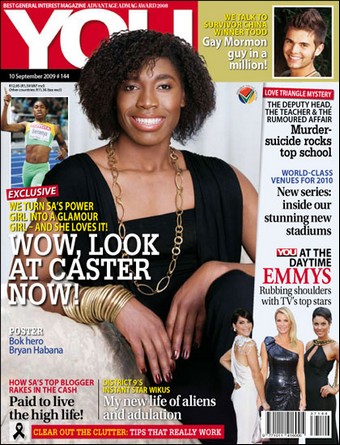
Notice that Semenya carries the same body into this photoshoot, but she is properly adorned with make up, feminine clothing, jewelry, a passive pose, and a pleasant and inviting facial expression (because to be feminine is to be accommodating).
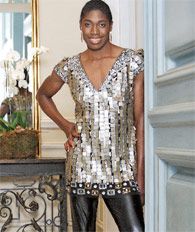
Perhaps more importantly, the copy and the interview tells the reader that Semenya likes dressing up and looking pretty, another important indicator of both femininity and non-masculinity. The cover says:
WE TURN SA’S POWER GIRL INTO A GLAMOUR GIRL – AND SHE LOVES IT!
(Notice, too, the implication that power and glamour are opposed.)
This insistence that Semenya feels (or wants to feel) feminine, as well as looks it, is mirrored in the text (as summarized by the Guardian):
It carries an interview with the 18-year-old student. “I’d like to dress up more often and wear dresses but I never get the chance,” she says. “I’d also like to learn to do my own makeup.”
The lifestyle magazine quotes Semenya’s university friends saying that she wants to buy stilettos and have a manicure and pedicure. Semenya adds: “I’ve never bought my own clothes – my mum buys them for me. But now that I know what I can look like, I’d like to dress like this more often.”
You magazine says that, after the photoshoot, Semenya told her manager that she would like to buy all the outfits she had modelled.
So, in the face of the leaked and unconfirmed finding that Semenya has undescended testicles and higher levels of testosterone than the “average” woman (see note at end*), there is an assertion here that what matters (i.e., the measure of sex that we should attend to) is her gender identity (feeling feminine) and her gender performance (doing femininity).
Anna N. at Jezebel points to how the public interest in Semenya’s sex may have pressured her, and those around her, to play this gender game. She writes:
…up until now, Semenya and her family have been unapologetic about the way she looks and dresses. Her father said that she had always preferred pants, but that she was still a woman — and the idea that she has to put on a dress and lipstick to prove her femaleness to people is pretty depressing.
It is also something that almost all women in Western countries do everyday. We perform gender, in part out of habit and in part consciously, all the time. Semenya hasn’t cared about this performance and that is at least in part why the controversy over her sex is taking the form that it is.
* Note: The release of male-related hormones, androgens, isn’t the whole story here. Cells must also have the relevant receptors for the presence of the hormones to matter. Semenya likely is lacking some of those receptors, either in her whole body on in parts of her body, because her body obviously didn’t respond to the hormones (otherwise she would have a penis and scrotum). My point here is dual: (1) the presence of testicles and testosterone doesn’t tell the whole story and (2) even if we knew the whole story, it doesn’t tell us if she is female or male. What if her body doesn’t detect the presence of those androgens? What if it reads the presence of some of them, but not others? What if she is chimera or mosaic? All these are interesting questions biologically, but the answers will not tell us whether she is male or female because sex, like gender, is a social construction.
—————————
Lisa Wade is a professor of sociology at Occidental College. You can follow her on Twitter and Facebook.
Lisa Wade, PhD is an Associate Professor at Tulane University. She is the author of American Hookup, a book about college sexual culture; a textbook about gender; and a forthcoming introductory text: Terrible Magnificent Sociology. You can follow her on Twitter and Instagram.…there’s Kleenex for men:
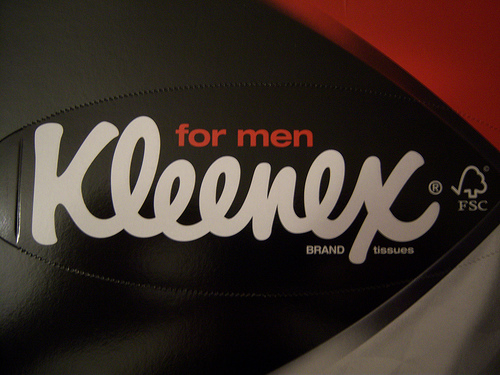
In case you don’t know that brown, black, and gray = men, it says so right on the box!

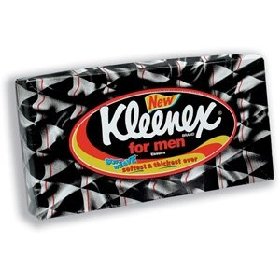
Apparently these are on sale in the U.K. I haven’t seen them in the U.S.
In looking this up, I discovered that gendered Kleenex marketing is nothing new. This ad, from Life magazine, is from December 1964:
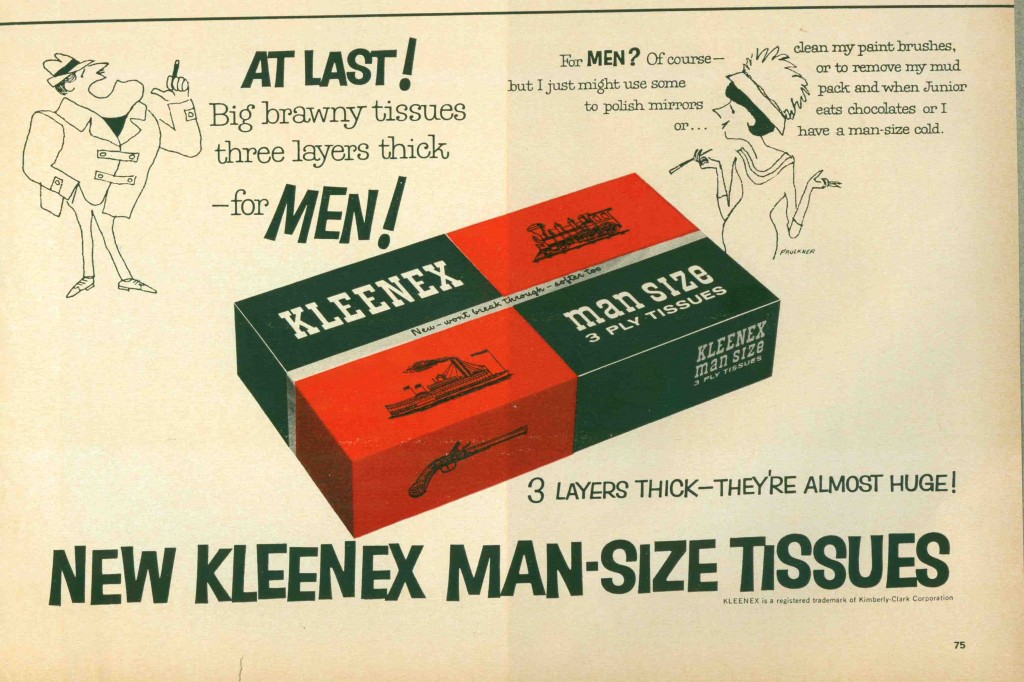
Images found here, here, here, and here.
Also in gendered products: tv dinners, uniforms, candy bars, ear plugs ‘n stuff, deodorant, Pepsi, and mosquito repellent.
—————————
Lisa Wade is a professor of sociology at Occidental College. You can follow her on Twitter and Facebook.
Cross-posted at Montclair Socioblog.
Claude the brand consultant was consulting with me – i.e., he was picking up the cappuccino tab at Starbuck’s. He was about to start teaching a course called something like “Communications and Public Affairs,” and not being an academic (though he’s a really good teacher), he wanted some advice on the syllabus.
We finally got around to the idea that Messages about Issues had to be tailored for specific Audiences or Publics, particularly their Interests and Values. (Those capitalized words were possible major headings in the syllabus.)
I immediately thought of the example of Texas and litter. How could you convince Texans to be more respectful of public places and not toss all that crap out onto the roads they drove on? The Ladybird Johnson approach – “Highway Beautification”?
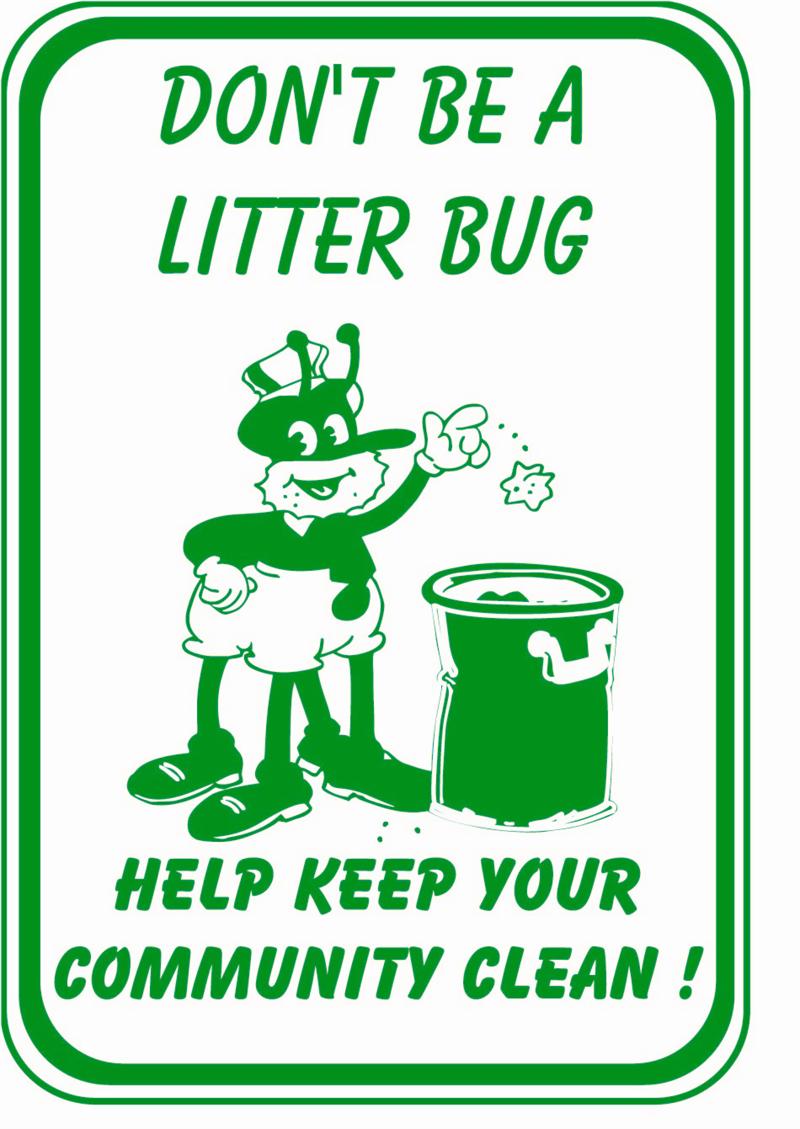
Wrong audience. The people who were littering obviously didn’t care about highway beauty.
The guy you were trying to reach was Bubba, the classic red stater – fiercely individualistic, anti-government, macho. A slob, and probably proud of it. You couldn’t appeal to self-interest since it’s in Bubba’s self-interest to chuck his garbage out the window. Even hefty fines (and they are hefty) would work only if you could catch litterers often enough – unlikely on the Texas highways.
The best way in was Values. But how? “Don’t be a Litterbug, Keep Your Community Clean” would be noo nice, too feminine or babyish, and, like “Pitch In” too collectivist. Instead, Roy Spence and Tim McClure at the Austin ad agency GSD&M had the Texas DOT go with chauvinism – Texas chauvinism. The idea they played on was not that littering was ugly or wrong or costly, but that it hurt Texas. And thus in 1985 was born one of the most famous and effective campaigns in the history of advertising.
With its double meaning of “mess,” it captured Bubba’s patriotism and pugnacity. The bumper stickers were soon everywhere. The TV ads featured famous proud Texans. One of the early ones (so early, I can’t find it on YouTube) featured Too-Tall Jones and Randy White, two of the toughest dudes on the Cowboys defense, picking up roadside trash.
JONES: You see the guy who threw this out the window, you tell him I got a message for him.
WHITE: (picks up a beer can): I got a message for him too.
OFF-CAMERA VOICE: What’s that?
WHITE: (Crushes the beer can with one fist). Well, I kinda need to see him to deliver it.
JONES: Don’t mess with Texas.
Litter in Texas has been reduced by 72%, the campaign is still going strong a quarter-century later, and McLure and Spence have a book about it. My source was Made to Stick by the Heath Brothers (no, jazzers, not thoseHeath brothers), Chip and Dan.
Brian Safi offers a fun tripartite typology of (mostly) gay men in advertising: (1) homoeroticism as simultaneously hilarious and disgusting in ads aimed at straight men, (2) coded gay cues in ads aimed at a general market, and (3) parallel ads, differing only slightly from each other, playing in straight and gay media. The second set of ads = especially hilarious. Enjoy.
—————————
Lisa Wade is a professor of sociology at Occidental College. You can follow her on Twitter and Facebook.
Lisa Wade, PhD is an Associate Professor at Tulane University. She is the author of American Hookup, a book about college sexual culture; a textbook about gender; and a forthcoming introductory text: Terrible Magnificent Sociology. You can follow her on Twitter and Instagram.Nice examples of the evolution of the diet industry and the role of businesses in trying to market their products as dietary aids (found here and here):
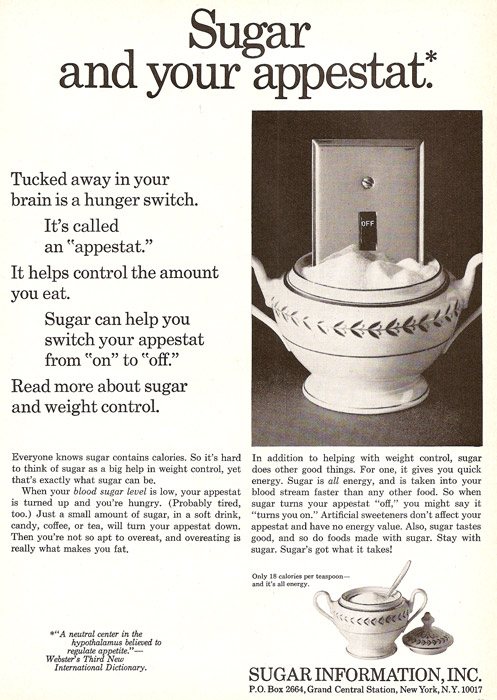
The fine print:
Everyone knows sugar contains calories. So it’s hard to think of sugar as a big help in weight control, yet that’s exactly what sugar can be.
When your blood sugar level is low, your appestat is turned up and you’re hungry. (Probably tired, too.) Just a small amount of sugar, in a soft drink, candy, coffee, or tea, will turn your appestat down. Then you’re not so apt to overeat, and overeating is really what makes you far.
In addition to helping with weight control, sugar does other good things. For one, it gives you quick energy. Sugar is all energy, and is taken into your blood stream faster than any other food. So when sugar turns your appestat ‘off,’ you might say it ‘turns you on.’ Artificial sweeteners don’t affect your appestat and have no energy value. Also, sugar tastes good, and so do foods made with sugar. Stay with sugar. Sugar’s got what it takes!
Only 18 calories per teaspoon…
and it’s all energy.
NEW (Dec. ’09)!
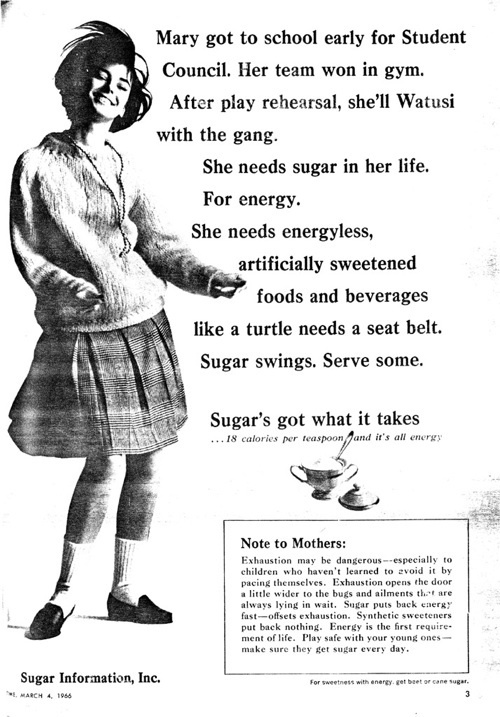
See also our recent post on marketing disguised as news.
—————————
Lisa Wade is a professor of sociology at Occidental College. You can follow her on Twitter and Facebook.